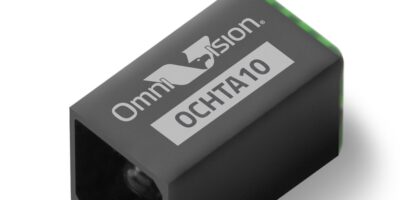Wafer-level camera module reaches inside the brain
A wafer-level camera by OmniVision Technologies, is small enough to access the smallest parts of a human anatomy, including the brain, spinal and cardiac procedures. The high resolution camera is designed for single-use endoscopies.
The OVMed OCHTA camera module has four times the resolution of its predecessor, namely 400 x 400, or 160kpixels. This, says OmniVision provides clearer images inside the body’s farthest recesses. The module features OmniVision’s CameraCubeChip wafer-level technology. As a result it matches its predecessors size of 0.65 x 0.65mm, for deep anatomical access. The technology also allows for the integration of OmniVision’s new higher-resolution OH0TA image sensor, which beats the Guinness World Record for the world’s smallest image sensor (held by its predecessor). It also has signal processing and wafer-level optics in a single compact package.
The integrated OH0TA image sensor is built on OmniVision’s PureCel Plus-S stacked die technology, which enables this module’s increased resolution at 30 frames per second. The pixel technology provides higher colour fidelity and low light sensitivity of 3600mV/lux per second and a high signal-to-noise ratio of 37.5dB for crisper images. It also offers higher full well capacity (FWC), zero blooming and 20 per cent lower power consumption of 20mW for greater patient comfort and longer procedure durations. This also reduces noise to produce crisper images. Images are further improved by the sensor’s exposure and gain control settings, which allow endoscope designers to fine-tune captures—prior to processing—for the best possible video quality under the lighting conditions of specific procedures.
Other key features include a wide 120 degree field of view and an extended focus range of 3mm to 30mm. This module also supports a four-wire interface, raw analogue data output, both of which can transmit via cables as long as four meters with minimal signal noise.
The OCHTA camera modules pave the way for endoscope, catheter and guidewire OEMs to develop mass-produced, single-use devices with 1.0 to 2.0mm optical diameters and higher resolution. These parameters are needed to address the challenges posed by reusable equipment, including cross-contamination risks and high maintenance costs.
Analyst Yole Développement continues to predict strong demand for single-use medical endoscopes, with an expected 27% CAGR between 2019 and 2025. Yole also predicts a US$241 million market at the end of that period for CMOS image sensor camera modules. “Reinforced by the COVID-19 pandemic, regulations from health authorities are strongly changing the endoscopy industry landscape,” explained Jérôme Mouly, team lead analyst, sensing and actuating at Yole. “The aim is to avoid cross contamination in high risk imaging procedures that use tiny endoscopes, like bronchoscopies, ureteroscopies or pediatric imaging diagnostics.
Aaron Chiang, marketing director at OmniVision, commented: “The OCHTA wafer-level camera module maintains the industry’s smallest size while quadrupling the resolution for single-use endoscopes, catheters and guidewires, which reduce the cross-contamination risks and downtime inefficiencies of reusable devices, as well as costs from their repairs, preprocedural testing and sterilisation.”
OmniVision remains the only company to offer small “chip on tip” camera modules with rear (backside) illumination (BSI), to improve image quality and for better low-light performance to help reduce LED heat and improve sensitivity. BSI also allows the use of superior lens technology when compared with front side illumination cameras in this class.
OmniVision added that the economical CameraCubeChip wafer-level packaging technology makes possible the mass production of high-resolution, single-use medical imaging equipment.
This module’s small size enables devices that can reach deep into the body for neuro, ophthalmic, ENT, cardiac, spinal, urology, gynecology and arthroscopy procedures, as well as dental and veterinary diagnosis and surgery. Alternatively, its size gives medical device OEMs the flexibility to create a larger-diameter scope with a larger working channel. By integrating the image sensor, signal processor and wafer-level optics in a single compact package, the OCHTA also reduces the complexity of dealing with multiple vendors while increasing supply reliability and speeding development time. Unlike traditional cameras, all CameraCubeChip modules are reflowable, i.e. they can be mounted on a PCB simultaneously with other components using automated surface-mount assembly equipment, which increases quality while reducing assembly costs.
The OCHTA camera module is available now for sampling in the tray format.




